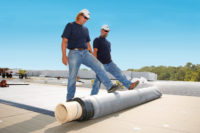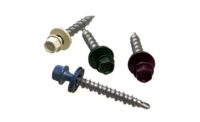From the first sign of smoke or scream of sirens as a building goes up in flames, there may only be minutes that separate a safe evacuation from a more serious scenario. The physical composition of construction materials and the building methods used to erect, fasten, and anchor the components are all factors in determining this time-safety window.
Building codes in the European Union require that roofing systems remain structurally sound for 15 minutes when a fire breaks out to give occupants time to evacuate. For example, commercial, industrial, and residential sheet metal roofs—popular in Scandinavia for their snow-shedding properties—must be able to withstand normal weights and loads at temperatures as high as 600 degrees Celsius (approximately 1100°F), close to the temperature at which aluminum starts to melt. Critical to their structural integrity is the performance of the powder-actuated fasteners (PAFs) commonly used to connect and install these roofing systems.
PAFs are basically nails, of numerous shapes and sizes, made of high-quality hardened steel with a tensile strength four to five times that of the base material. Using a small explosive charge, they are “shot” like a bullet from a nail gun at 600 meters per second—a speed and force powerful enough to drive the fastener into the building’s steel or concrete superstructure—displacing the substrate material and anchoring the fastener.
First developed for underwater ship repair in 1915, PAFs are still widely used today in the shipbuilding industry and also in roof and composite floor-frame-system construction. A simple low-tech device, surprisingly similar to their century old precursors, PAFs are the key to keeping modern metal roofs structurally secure under any conditions — including fire.
Putting PAFs Under the Microscope
While PAFs are relatively simple, much is still unknown about the characteristics and installation methods that contribute to their strength and durability. For instance, numerous tests have been conducted on pull-out forces, but there has been very little research on shear resistance, which can be important in scenarios such as fire. As a result, current design recommendations are based primarily on the information readily available for bolts and rivets.
To advance the knowledge of structural and mechanical engineers in the construction industry, a group of engineering researchers in Finland collaborated to study the load-bearing and lap-shear behavior of PAFs under ambient and fire conditions. The group included: Ruukki Construction (a major supplier of sheet metal and load-bearing steel sheets to the construction industry), Aalto University’s Department of Civil and Structural Engineering (a group involved in research on the fire-engineering design of steel structures), and Z.Ma Research and Consulting (a structures and strength consultant specializing in using complex simulation technologies).
For a deeper understanding of the real-world physics behind the seemingly simple PAF lifecycle—from nail driving, to extreme heating, to shear loading—Dr. Ma and the Aalto University research team chose Abaqus finite element analysis (FEA) software from SIMULIA, the Dassault Systèmes brand for realistic simulation. “Abaqus provides very good functionality for solving a highly nonlinear problem under complex dynamic, transient dynamic, and thermal loading,” said Dr. Ma.
The FEA models for the PAF consisted of a thin plate on top (equivalent to the sheet metal roofing), a thicker plate on the bottom (corresponding to the building’s steel substrate), and a standard fastener with its three-part, head-shank-tip shaft structure separated by two washers (see Figure 1). The thick plate was modeled using an Eulerian, or fixed, frame of reference (EC3D8R elements), while the thin plate and fastener used the Lagrangian or moving frame (C3D8R elements).
Relying on Abaqus capabilities, Dr. Ma divided the PAF analysis into a sequence of separate steps that examined the strength of the nail for all phases of the installation process including before driving, after driving, and after “springback” (a step that takes into account the elastic rebound of the materials and the “welding” phenomenon between the nail shank and the thick plate). He also used the model to simulate the residual stresses, deformation, and plasticity in the PAF, thick plate, and thin plate (see Figure 2), the heating of the fastener-plate samples to increasingly hotter fire temperatures (200, 400, and 600°C), and the addition of lap-shear displacement loads to analyze the load-bearing characteristics of the fastener assembly.
“The Coupled Eulerian-Lagrangian formulation in Abaqus/Explicit was especially well suited for such an analysis since it can account for material nonlinearity, contact nonlinearity, and progressive failure prediction while still handling significant deformations,” said Dr. Ma. “Abaqus was able to carry out the multi-step simulation efficiently with its parallel computing capabilities.”
Checking the Results
For the thin plate, the simulation identified the four major components responsible for the shear resistance load: the bearing force between the thin plate and nail shank; the frictional force between the washer and the thin plate; the frictional force between the thin and thick plates; and the bearing force of the two washers due to the tilting of the thin plate as a load is applied.
The simulation also showed that as the fastener penetrated the substrates, the material of the thick plate flowed up and outward around the nail, forming a protuberance feature that grew in height as the nail went deeper. When the nail shaft reached the qualified installation stand-off height of 8-11 mm above the surface, all layers of the sample (thin plate, thick plate, and washers) contacted each other tightly and the protuberance was its tallest (1.5 mm high at an 8 mm stand-off height) (see Figure 3).
The study determined that at qualified stand-off heights, the protuberance feature provided a 30 to 60 percent increase in the PAF’s load bearing resistance: basically, the deeper the nail is installed (within specification), the taller the protuberance becomes and the more durable the connection is at ambient and high-heat conditions when subject to lap-shear loading (see Figure 4).
To validate the studies, the team at Aalto University conducted physical testing on a series of specimens representative of a typical cold-formed sheet metal roof fastened with PAFs and identical to those used in the computer model. Comparisons of Abaqus FEA results with measured load-displacement at both ambient and elevated temperatures showed good correlation for the assembly (see Figure 5).
In the past, physical testing was the only way to evaluate the effectiveness of PAFs. Now with finite element modeling and analysis methods in Abaqus, designs of fasteners as well as best practices and specifications for installation can be evaluated outside the lab, before reaching the construction site.
“Using finite element analysis, we were able to determine the contribution of each factor in PAF assembly and roof strength,” said Dr. Ma. “The results of our study may indicate that fewer fasteners can be used to keep roofs structurally sound.”
That’s a finding that should get the attention of anyone responsible for keeping the roof over our heads safe, even when there is a fire.
For more information about SIMULIA, visit www.simulia.com. Zhoncheng Ma can be reached by e-mail at zhma2008@gmail.com














